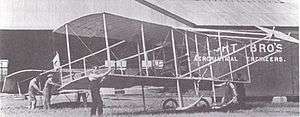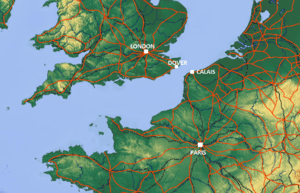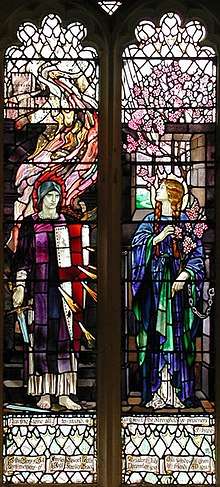Cecil Grace
Cecil Stanley Grace (1880 – 22 December 1910) was a pioneer aviator who went missing on a flight across the English Channel in 1910.
Cecil Stanley Grace | |
|---|---|
| Born | 1880 Chile |
| Died | 22 December 1910, (Age 30) English Channel |
| Nationality | British |
| Occupation | Pilot |
| Known for | Pioneer aviator |
Family
Grace was born in Chile, the son of John William Grace of New York. His uncle was W. R. Grace, a former mayor of New York City and founder of W. R. Grace and Company. Grace was naturalised as a British citizen in October 1910.[1]
Eastchurch
In 1909 members of the Aero Club of Great Britain established a flying ground at Eastchurch on the Isle of Sheppey. Grace was one of this early group of pioneering aviators, and in April 1910 he was awarded only the fourth Royal Aero Club Aviator's Certificate.[2][3]
Prior to his death, Grace had arranged to give free flying lessons to prospective pilots nominated by the Royal Navy. The lessons were subsequently given by another aviator, George Cockburn.[4]
Final flight



In 1910, a number of early aviators were competing for the Baron de Forest Prize of £4,000 for the longest flight from England into continental Europe.[5] Tom Sopwith was the first to try with a 170-mile flight into Belgium on 17 December 1910. Claude Grahame-White crashed his aircraft before he could make an attempt. Grace departed Swingate Downs on 22 December 1910 flying a Short S.27 in an attempt at the prize.[6] The sea was covered in mist, but a telegram was received that Grace had landed due to the strong winds near the village of Les Baraques near Calais.[6]
He eventually made it to Calais, but with strong winds he decided to return to Eastchurch via Dover and attempt a prize flight on another day.[6] After lunch in Calais at about ten past two in the afternoon Grace left Calais to return to England. The journey to Dover was expected to last no longer than 40 minutes, but by 3:30 he had not arrived.[6] An aeroplane had been sighted by the Coastguard from Ramsgate at about 3 o'clock about six miles out to sea near the Goodwin Sands heading north.[6]
For a few days it was hoped that Grace had managed to land somewhere, but on 6 January 1911[7] a pilot's goggles and cap were washed ashore at Mariakerke (west of Ostend Belgium) were later identified as Grace's.[8][9] Reportedly his aircraft wreckage was found near the same location.[10] A body resembling Grace's was found in Ostend harbour on 14 March 1911, but it was too badly disfigured to be identifiable.[11][12]
In March 1911 he was formally declared to have died.[13] There is a stained glass window in the south wall of All Saints' Church, Eastchurch, dedicated jointly to Grace and to Charles Rolls who died the previous July.[14] Grace's name also appeared on a monument celebrating the earliest cross-channel flights, erected at Calais by the Aero Club de France around July 1911.[15] He was posthumously awarded the Gold Medal of the Royal Aero Club "for his achievements as a pilot and competitor".[16]
References
- "News in Brief". News in Brief. The Times (39419). London. 2 November 1910. col F, p. 20.
- Flight 16 April 1910
- Dallas Brett, R. History of British Aviation 1908–1914. John Hamilton Ltd, 1933.
- Guy Warner (13 June 2011). World War One Aircraft Carrier Pioneer: The Story and Diaries of Captain JM McCleery RNAS/RAF. Pen and Sword. pp. 15–. ISBN 978-1-78346-130-1.
- Roberts, Priscilla Mary, ed. World War I: A Student Encyclopedia. p. 1706. ABC-CLIO, 2005. ISBN 1-85109-879-8.
- "British Airman Missing. Mr. Grace Lost Over The Sea After A Channel Flight". News. The Times (39463). London. 23 December 1910. col C, p. 8.
- "Fate of Cecil Grace". New York Tribune. 15 March 1911. Retrieved 3 January 2015.
- "The Disappearance of Mr. Grace. Discovery of CAP And Spectacles". News. The Times (39475). London. 6 January 1911. col F, p. 8.
- "The Disappearance of Mr. Grace". News. The Times (39476). London. 17 January 1911. col F, p. 8.
- "Believe Body is that of Missing Aviator". Salt Lake Tribune. 15 March 1911. Retrieved 3 January 2015.
- "Grace's Body Found?; One Much Disfigured, Resembling Lost Aviator, Picked Up at Ostend". The New York Times. 15 March 1911.
- Evening star., March 15, 1911, Page 11, Image 11
- "Airman's Death in the Goods of Cecil Stanley Grace". Law. The Times (39544). London. 28 March 1911. col E, p. 3.
- Eastchurch Parish Council Archived 22 May 2010 at the Wayback Machine. Accessed 21 May 2010.
- Flight 1 April 1911 p.299
- "Awards & Trophies: Gold Medal of the Royal Aero Club". Royal Aero Club. 2009. Archived from the original on 16 July 2011. Retrieved 19 June 2010.